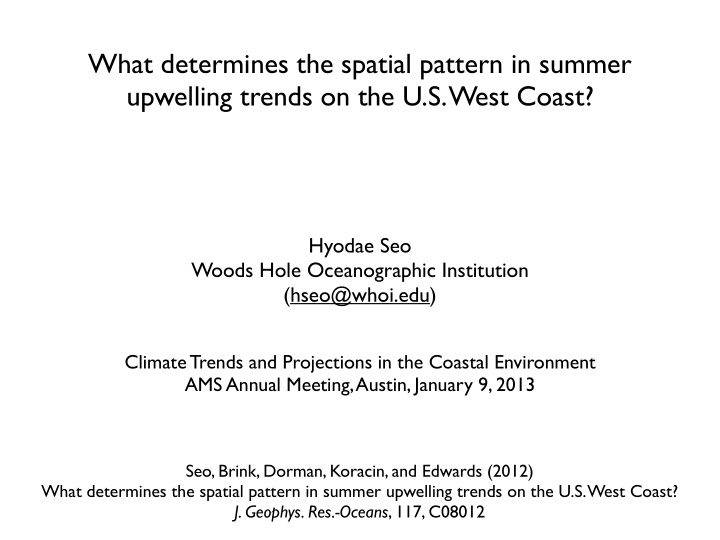



What determines the spatial pattern in summer upwelling trends on the U.S. West Coast? Hyodae Seo Woods Hole Oceanographic Institution (hseo@whoi.edu) Climate Trends and Projections in the Coastal Environment AMS Annual Meeting, Austin, January 9, 2013 Seo, Brink, Dorman, Koracin, and Edwards (2012) What determines the spatial pattern in summer upwelling trends on the U.S. West Coast? J. Geophys. Res.-Oceans , 117, C08012
Motivation and Questions • Coastal upwelling is a fundamental oceanographic process for cold over-shelf SST during summer seasons. • A robust assessment of long-term variability and trend in upwelling remains difficult due to short spatial scales (~10 km). • On the U.S. West Coast, long-term in situ data are more abundant. • Main questions of the study: • Long-term trend and pattern of upwelling? • Possible mechanisms? • Impacts on near-coast land air temperatures?
Data and reanalysis • SST and wind: National Data Buoy Center (NDBC) buoys. 1981-2010, 1- hourly. http://www.ndbc.noaa.gov • Satellite SST: NOAA OI SST based on AVHRR, daily 25 km,1982-2010, Reynolds et al. (2007). http://www.ncdc.noaa.gov/oa/climate/research/sst/oi- daily.php Consistent with NDBC buoy SSTs. • Wind stress and curls: California Reanalysis Downscaling at 10km (CaRD10). Dynamic downscaling of the NCEP/NCAR Reanalysis, 1948-2005 at 1- hourly, 10km res. over California http://g-rsm.wikispaces.com/CaRD10. Good skill over NDBC buoys (Kanamaru and Kanamitsu, 2007). • Land air-temperatures: California Weather Database. Daily Tmax, Tmin, and Tave, 1951-2010. http://www.ipm.ucdavis.edu
Trend and spatial pattern in JJA SST 1980-2010 JJA SST Trend [°C/decade] • Over-shelf buoys and NOAA SST both show a coast-wide cooling trend . • This cooling trend has a greater magnitude in the central and southern California. Buoy SST NOAA SST All 12 buoys -0.19 -0.26 Northern 6 -0.14 -0.19 buoys Southern 6 -0.24 -0.32 buoys Buoy SST Trend [°C/decade]
Along-shore distribution of trend in upwelling and wind — buoys SST Alongshore wind — NOAA • North: The variability and trend in SST are positively correlated with those of the equatorward wind. ‣ Indicative of a role of offshore Ekman transport. • South: Even stronger trend and variability are associated with winds with weak or opposite trends and correlations. Then, what determines the long-term SST trend in the south?
What determines the southward intensified upwelling trend pattern? JJA Trends (1980-2010) in wind stress and wind stress curls in CaRD10 • Wind stress has southeastward trend coast-wide, except in the lee of capes, which show poleward trend. • These regions are associated with trend in positive wind stress curls. Can Ekman pumping account for greater upwelling trend in the south?
Ekman transport by along-shore wind stress vs Ekman pumping by curl? Trend in JJA Integrated EkP JJA 1980-2010 Trend in JJA EkT $ ' EkT = 1 1 ∧ ∇× τ d ∫ EkP = ) dx τ × k & f 0 ρ w ρ w f % ( unit: m 3 s -1 per 100 m of d=cross-shelf-distance coastline where curl>0 e.g., Puduan and Pickett, 2003 • Much stronger contribution to the total upwelling transport from integrated Ekman pumping • Most pronounced in the lee of Pt. Sur and Pt. Conception • Curl-driven Ekman pumping is a possible mechanism for greater upwelling trend in the south.
What is the role of large-scale modes of climate variability? Example of Pacific Decadal Oscillation (JJA 1980-2010) Regression (all de-trended) Regression Inferred SST trend Coefficients All 12 buoys +0.88 -0.42 Northern 6 buoys +0.87 -0.41 Southern 6 buoys +0.90 -0.42 PDO-induced buoy SST trend = de-trended reg. coef X PDO trend • West Coast SST has positive reg. coeffs. with PDO index. • The SST trends inferred from PDO are comparable in the south and north, • PDO would not likely explain 70% greater trend in the south as in buoys. • The topographic wind stress curl could be a factor for local trend pattern.
Upwelling trend and over-land daily mean air-temperatures (Tave) JJA Tave Trend 1951-2010 JJA Tave Trend 1980-2010 Tave not sig Tave Tave sig SST • Daily-mean air-temperatures have been rising significantly (p=0.1). • Greater inland warming trends in 1980-2010 than 1951-2010 • In 1980-2010, near-coast stations show weaker warming or even cooling trends, in agreement with cooling trend in air-temperatures over buoys.
Daily averaged temperature: Tave City of Lompoc • Tave has a cooling trend of -0.5C/decade in 1980-2010. • Coincident with the cooling in over-shelf air/water temperatures. • Only Tmax shows substantial Daily maximum temperature: Tmax • cooling trend of -1C/decade. • Tmax trend influenced by a stronger intrusion of marine Daily minimum temperature: Tmin air via sea breeze (e.g., Lebassi et al. 2009).
Summary and Discussion • In situ and remote-sensing data both indicate that summer-time WC SSTs have been cooled at -0.19~-0.26 C/decade in 1980-2010 (e.g., García-Reyes and Largier 2010 ) . • Off Oregon and northern California coast, cooling trend is consistent with the upwelling response to the equatorward alongshore wind stress. • In central and southern California, pattern and trend in wind stress curl seem to better account for even stronger (70%) upwelling trend. • Caveat 1) Uncertainty in trend of wind stress curl, • Caveat 2) Other factors not considered: alongshore pressure-gradient and currents. • The coast-wide trends in SST and wind are associated with PDO, • but, not their alongshore distributions. • Upwelling trend may have some impacts on long-term trend in over-land diurnal temperature variability possibly through sea-breeze intrusion.
Thanks
Recommend
More recommend